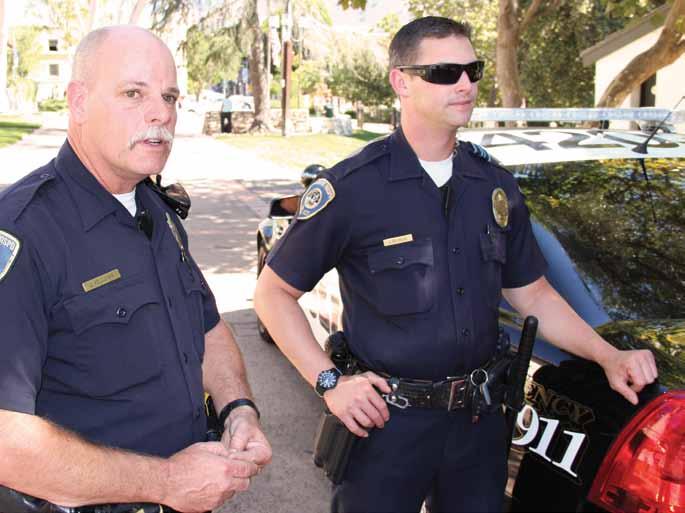
12 minute read
COMMUNITY
What You Should Know About THE JIM & JEREMY SHOW
An insider’s look at the daily effort to address homelessness in San Luis Obispo
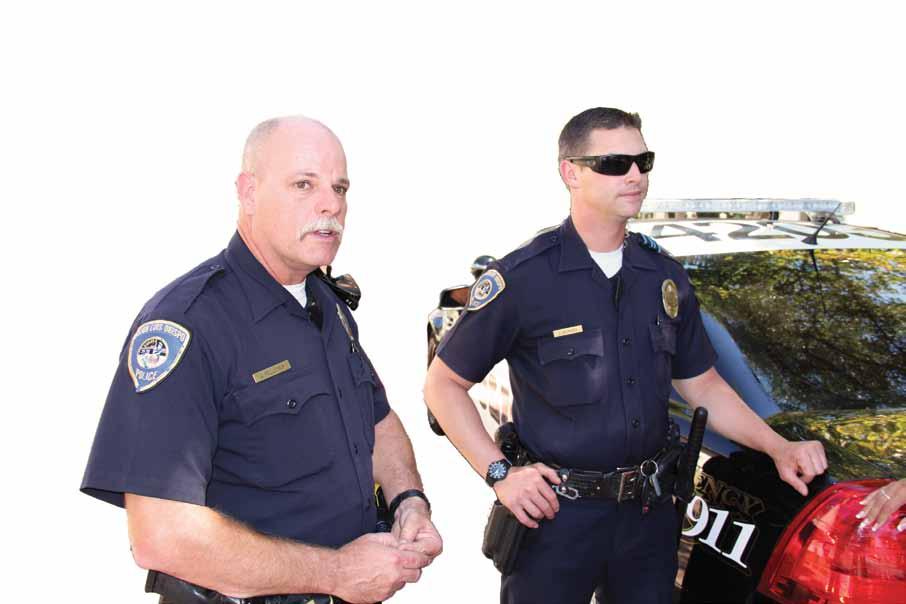
On the front lines of a very complex homeless issue in San Luis Obispo stand Jim Fellows and Jeremy Behrens, the two police officers handpicked to lead the newly formed Community Action Team (CAT). We rode along with them recently, and here is what we found… As we approached the first group of transients, one of them stood up and jokingly called out, “Oh no, it’s Officer Fellows! Everybody run!” Without missing a beat, Fellows retorts with a friendly smile, “Hey, Curtis, what’s up, man?” The two men meet with a respectful handshake. The conversation is cordial, but as it continues the officer’s questions become increasingly difficult. “What are you doing with your day?” And finally, “What are you doing to try to get yourself out of this situation?” Curtis gives a long, but unconvincing answer. While Fellows talks with Curtis, Behrens quickly assesses the rest of the group. One of them, just a kid in his early twenties, locks eyes with the officer midway through a sip from his beer can. Behrens approaches the kid, who starts to panic. “Oh, man, I don’t need this,” he tells the officer. A stone-faced Behrens orders him to pour out his beer and begins writing a citation for drinking in public. “You don’t understand, this is my third one,” the kid reveals, now nearly in tears. Behrens confirms his concern— the third violation for drinking in public is automatically upgraded to a misdemeanor. The kid, who asked to not be identified, explained
that he was from New York and was just here for a while because he had heard that San Luis Obispo was a good place to “mellow out.” He told the officer that he would not be in town long enough for his court appearance anyway. Behrens did not reply to the comment and instead handed him his citation.
This new approach to homelessness takes a direct, one-on-one approach to the problem. The two officers have been given broad support, but most importantly, the “time and space,” as they describe it, to do in-depth intelligence gathering with this population. The concept is not a new one in policing, in fact, the Santa Barbara Police Department has a similar program that is a few years in the making. They have three full-time officers there dedicated to the homeless population and have served as a model to the SLOPD. In fact, Officers Fellows and Behrens have spent time there trying to absorb best practices and take words of advice from their Santa Barbara brethren. The officers have seen progress so far, but caution that it is incremental. If this were football, we are not talking about long bombs here; instead, it’s three yards and a cloud of dust. As they travel around the streets of San Luis Obispo, the officers constantly refer to a black vinyl-bound binder labeled “CAT Client Book.” The pages are a collection of mug shots and notes about each known homeless person in town. A steady stream of homeless related calls flow in from the SLOPD dispatcher throughout the day; mostly complaints from citizens who feel some level of threat from this population. The police department claims that around 30% of their calls are of this variety and are usually related to aggressive panhandling. But, traditional methods for dealing with these problems have not been working. “What we’ve dealing with up to this point has been a revolving door,” explains Behrens, who describes a familiar phenomenon where the same transients—who they refer to as “frequent flyers”—are arrested over and over again for the same violations, booked at county jail, released, fail to appear for their court appearance, get arrested again, taken to jail again, and so on.
To address this cycle, an innovative concept called Community Court has been championed by SLOPD Chief Steve Gesell and has been widely praised as a step in the right direction. When discussing the homeless issue, Gesell is fond of using the phrase “carrot and stick,” in describing the various tactics for dealing with this population. Community Court would be the “stick” that currently does not exist. According to Gesell, “We have to change the culture. People need to understand that there are going to be consequences for their behavior.” As it is now, there really are not many consequences—a transient can skip a court appearance for a misdemeanor without much concern for any repercussions, because they know that the judge will not issue a warrant for their arrest. Community Court will aim to change that because it will operate outside of the traditional judicial system, which is already overburdened, and will give chronic offenders an option to choose either the “carrot,” drug and alcohol treatment, or the “stick,” jail time. Commissioner Stephen Sefton will preside over the court and arrest warrants will be issued for failing to appear. Sheriff Ian Parkinson has set aside ten jail beds, providing space for those sentenced by Community Court.
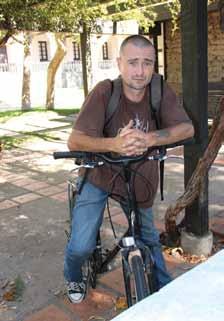
Biding his Time Jason “Jay” Ogle claims to have spent 27 years in prison for murder— apparently for returning fire after his cousin was shot. From Indiana, he was picked up in Los Angeles for an unspecified violation. He then moved to Ventura County where he claimed he was “kicked out,” so he traveled further north to San Luis Obispo where he says, “People leave me alone.” He intends to return to Indiana to become a long-haul trucker once his parole ends.
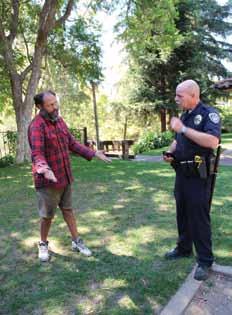
Keeping Tabs A long-time San Luis Obispo-based transient, Carmen Lotido, who struggles with schizophrenia, talks daily with Officer Fellows. “All we can do is check in with him and make sure he is taking his medication,” says Fellows, “because when he doesn’t, it’s a really bad situation.”
A NEW TACTIC
In the words of SLOPD Chief, Steve Gesell...
I was having lunch downtown last week with the new fire chief. When we left the restaurant, a transient came up to us. He clearly had been drinking and was waiving his arms and yelling, “Stay away from me!” But, he kept coming toward us.
I asked him, “So, what are you going to do with the rest of your day?” He said, “I’m going to bake [take drugs].” He told me that he spent his time downtown in front of Frog & Peach and that it was mostly college students who gave him his money. I asked, “How much do you make in a given day?” He said, “Between $80 and $200.”
He was a hair away from going to jail, but he held himself together and gained his composure while we talked. Fire Chief Olson then asked him, “What’s your drink of choice?” He said it was a beer called “Hurricane.” He told us that he drank 14 of them a day.
My next crusade is to stop retailers from selling these beverages to people who obviously should not be consuming them. This individual should not be able to walk into a liquor store 14 times a day to buy this product. We have started a dialogue with liquor stores in the city and, so far, they have been receptive because this absolutely has to stop. ” Throughout the day, the officers take on various roles that swing quickly from parent to coach to friend to caseworker to motivational speaker and, of course, police officer. They know every transient by name and have patiently built some level of rapport with each one. But, underneath the friendly scene that unfolds, a hard truth remains. “A lot of them are very resistant to what we have to say,” shares Behrens. “They are out here because they want to be here and to try to change their minds is very, very hard.” Ultimately, that is what it comes down to because, as it stands now, a homeless person cannot be forced into receiving recovery services. They have their own free will and, as the officers point out, enjoy the same rights as everyone else. And many of them know exactly where those rights begin and end and are careful to toe the line. “I’ve seen guys pull out a tape measure in front of Food 4 Less to make sure they are not breaking the law that says they must be at least 6 feet from a doorway [when panhandling],” says Fellows. The day continues along the same lines following a consistent, deliberate pace. The officers drive around to known homeless hot spots and respond to calls from dispatch. Notes are made on each encounter and the pair regularly checks in via cell phone with various service providers around town. Transitions Mental Health seems to be one of the most frequent calls, as they share many clients in common, because the fact remains that a large percentage of the homeless population deals with some level of mental illness. Fellows estimates the number at 50%, while Behrens suggests it is higher, perhaps as much as 65%. Despite the 15-point difference in their estimates, both do agree that the severity of illnesses varies greatly and that nearly 100% of them self-medicate with drugs or alcohol— usually both. And, the only way they are able to do this, the officers note with a perceptible level of frustration, is due to the fact that people keep giving them money.
There is a proposal winding its way through City Hall called the Directed Giving Campaign. Research exists showing that approximately $.90 out of every dollar donated to a homeless person is used to purchase drugs and alcohol. The proposed program will create a platform to ensure that donations will go toward food, shelter, and recovery services. Initially, three to seven downtown parking meters would be equipped to accept donations to the homeless population. A non-profit intermediary, such as the United Way, would receive those funds and administer them to organizations such as CAPSLO’s Prado Day Center, or the Maxine Lewis Overnight Shelter. Therefore, a citizen who is asked for money by a panhandler can say, “Sure, let me just slip my credit card in this meter and I will gladly donate $5.” The program will also be accompanied by a public awareness campaign. A draft graphic is in the works showing a hand dropping a pile of coins toward another hand. On the way to its destination from giver to receiver, the coins begin morphing into syringes and beer bottles.
During a quiet moment in the car between calls, Fellows shares that it was a slow summer at Sweet Alexis, a bakery his wife operates in Los Osos. He then becomes philosophical about the CAT assignment. “We all have a personal
HURRICANE
This 40-ounce malt liquor drink made by Anheuser Busch contains the highest alcohol content at the lowest price. At 5.9% alcohol—about the same as is found in an entire standard six-pack—it is currently available for around $1.99 in most San Luis Obispo liquor stores.
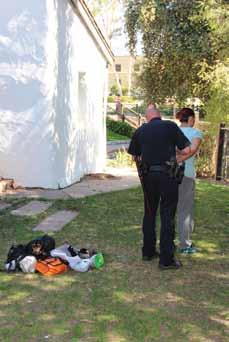
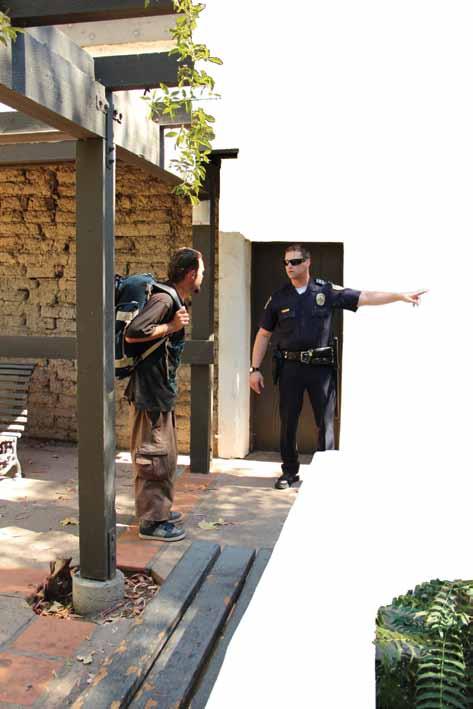
Wanted Woman
A cordial exchange takes place during the arrest of a woman who the officers know well. “We had higher hopes for her,” explains Fellows. “But, hopefully, this will serve as a wake-up call.”
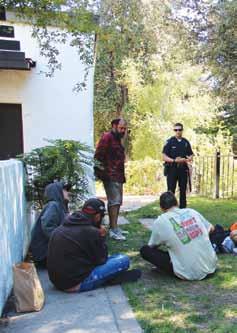
A Day in the Life
Officer Behrens starts the morning off in his usual fashion, by greeting the downtown regulars. After a friendly conversation, where the goal is to build rapport and gain intelligence, the question is asked: “What are you doing to get yourself out of this situation?” Dazed and Confused

One transient, a young man with a new backcountrystyle pack wanders up and asks how to get to Santa Cruz. “Go to Santa Rosa and make a left,” points Behrens. “Whoa,” the young man says, “We’re in Santa Rosa?”
interest in these people, because they are people just like you and me,” he says. “And a lot of them have not been shown any love, for lack of a better word.” Those words hang in the air for a moment when his phone rings. On the other end of the line is a member of the downtown private security force who spotted a woman they have been searching for over the past three weeks. There is a drug-related warrant out for her arrest, but she had “disappeared for a while.” The tipster reveals she is at Mission Plaza above the creek. Fellows looks over his shoulder before effortlessly executing a U-turn while strategizing with Behrens about how to best apprehend the suspect. Let’s just go up and talk to her, they decide. The conversation is very surface and the tension is palpable. A group of transients look around as if they were in one of those classic Old West movies where everyone places their hand above their six-shooter resting in its holster, only to wait for the other guy to make the first move. The suspect is clearly busted. She tries her best “my dog ate my homework” rationale for why she did not make her court appearance, but it goes nowhere. After realizing the obvious futility, she stands up, says goodbye to the group, and exposes her wrists for Fellow’s handcuffs. The entire exchange is characterized by respect, and the officers take great care in gathering her personal belongings. As the suspect is placed into the squad car, she becomes anxious about her bag. “Where’s my bag? Don’t forget about my bag,” she calls out. “I’ve gotta have my bag.” The officers tell her not to worry; they have the bag and everything in it. She then sinks heavily into the back seat, visibly relieved after hearing the news.
A call is made to a counselor at Transitions Mental Health who shows up almost immediately. After she reconnects with her client, the squad car rolls off toward county jail, and the small crowd of curious bystanders that had gathered near the Mission begins to dissipate. But, one onlooker remained—a tourist who finally musters the courage to approach Behrens and ask why the suspect was so worried about her bag. “Did it have drugs, and weapons?” he asked excitedly, as if inquiring with a friend about how a movie had ended. “No,” Berhens stated flatly, “it was just pictures of her kids, and a DVD of her daughter’s ballet recital.” SLO LIFE










